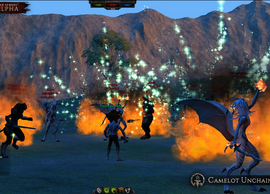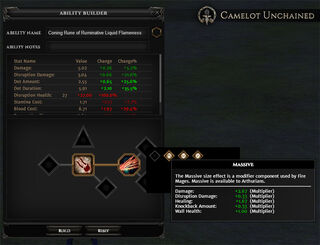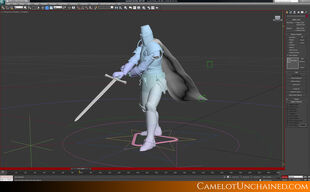JamesGoblin (talk | contribs) mNo edit summary |
JamesGoblin (talk | contribs) (→Combat-body parts/armor: Added "Developer Quotes" secthion) Tag: Visual edit |
||
| Line 48: | Line 48: | ||
# Abilities also have a “Disruption Value” which is damaged by “Disruption Damage” from hostile abilities. If an ability takes too much disruption damage, it is interrupted. Too much disruption damage can result in a very negative effect on the player whose ability was disrupted. |
# Abilities also have a “Disruption Value” which is damaged by “Disruption Damage” from hostile abilities. If an ability takes too much disruption damage, it is interrupted. Too much disruption damage can result in a very negative effect on the player whose ability was disrupted. |
||
# The more [[Ability Building System|powerful]] the ability disrupted, the more likely the backlash from the ability will hurt the user of the ability. |
# The more [[Ability Building System|powerful]] the ability disrupted, the more likely the backlash from the ability will hurt the user of the ability. |
||
| + | |||
| + | == Developer Quotes == |
||
| + | Mark Jacobs: I want a combat system that is reactive, flows smoothly, fluid/etc. and one where the player(s) have to think a little for themselves without the game doing so much for them. I also don't want to see CU be a game where combat boils down to "1-2-3" "1-2-3" "1-2-3-4" rinse, wash repeat. |
||
==Vines== |
==Vines== |
||
Revision as of 00:06, 27 August 2015
A brawl (pre-alpha)
| |
|---|---|

|
The combat system of Camelot Unchained is planned to be tactically complex, with a vast number of options through the Ability Building System - players will be building their own abilities out of Components.
Combat is designed with significant consequences - characters who die in battle won't get easily right back in the fight. Player`s skill progression / leveling up will also be direct consequence of fighting enemies from other Realms - you will progress through PvP, not through quests or killing monsters.
Overview

Skirmish (early alpha)
- Players create all their own abilities: nothing except the core components of an ability are premade.
- Considered the epitome of “choices matter,” part of the Foundational Principles.
- Four different categories of components, many with their own customization, yields a huge number of possible combinations.
- Players can create abilities to match their preferred playstyle, not just play the classes that are created for them.
- System supports hard interrupts, positionals, reactionaries, and other staples of combat systems.
Combat
- Combat will be based on 'Rock, Paper, Scissors' mechanics and class inter-dependence through the "Holy Trinity" of combat characters and strong archetypes. [1]
- Quote: "Combat, including magical combat, should be innovative and fun. The world has enough MMORPGs with combat systems that are the same or strikingly similar to other MMORPGs." [2]
- The combat system is specifically designed with experienced players (or players who want a greater challenge) in mind. [2]
Component Combat System

Ability builder in action
- Uses a variant on the component magic system used in previous games, particularly the MUD Dragon's Gate, also by Mark Jacobs.
- All abilities are created by each player for themselves through the Ability Building System.
- Combat is partially balanced by the power of each ability, which is limited by a value rating limit, which represents how strong an ability can be after modification by the player.
- With each new component added to an ability, the value rating goes up. It cannot surpass the value rating limit of the ability.
- Many components also have a range of adjustments that can be made, once again raising the value rating.
- Players have precise control over the value rating and all the adjustments made to it.
Combat-body parts/armor

Animating Stormrider`s sword combat
- Each part of a character’s body is protected only by its own piece of armor
- Unlike the way of most games, armor only protects the part of the body that it covers. Your helm doesn’t help you when you are struck on the leg!
- Body parts take damage individually, and each part has its own pool of health and injury effects
- A shoulder wound could reduce how fast a player can swing a sword, but it won’t stop that player from running away
- Player-created abilities can add a modular component to target a specific region of the body
- Paying careful attention can give the attacker an advantage, but if the attacker targets an area that the defender is guarding or quickly moves to protect, the advantage could shift
- Certain components will also allow a defender, after a successful defense, to perform a special counter-attack on the attacker
- Abilities always trigger cooldowns once started, and cost resources whether they complete successfully or not.
- Abilities also have a “Disruption Value” which is damaged by “Disruption Damage” from hostile abilities. If an ability takes too much disruption damage, it is interrupted. Too much disruption damage can result in a very negative effect on the player whose ability was disrupted.
- The more powerful the ability disrupted, the more likely the backlash from the ability will hurt the user of the ability.
Developer Quotes
Mark Jacobs: I want a combat system that is reactive, flows smoothly, fluid/etc. and one where the player(s) have to think a little for themselves without the game doing so much for them. I also don't want to see CU be a game where combat boils down to "1-2-3" "1-2-3" "1-2-3-4" rinse, wash repeat.
Vines
Videos
Combat animation basics:
Early ability builder in action (skip to 0:45):
BSC Days combat:
